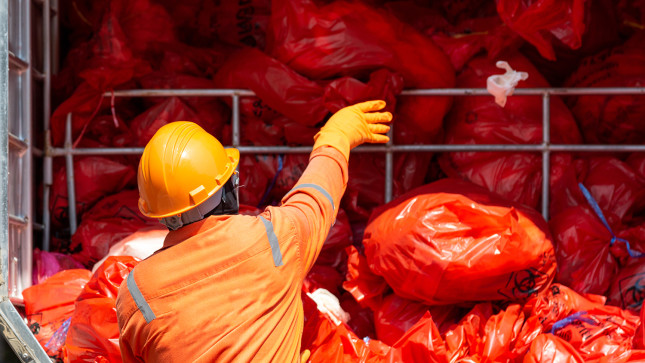-
Mountains and Molehills: Medical Waste in China and the U.S.

At the initial epicenter of the COVID-19 pandemic in Wuhan, China, the daily output of medical waste soared five times its average volume — from about 40 tons to as much as 250 tons at the end of February. This overwhelmed Wuhan’s single specialized medical waste treatment plant, far exceeding its 50 tons-per-day processing capacity. As the pandemic progressed throughout China, it revealed the shortfalls in medical waste management capacity in many cities. At a news conference in Beijing in March, Zhao Qunying, director of the emergency management office of the Ministry of Ecology and Environment, reported that 22 cities were operating over-capacity and 28 cities were working at full or near full load.
Medical waste refers to healthcare waste that may be contaminated with blood, bodily fluids, or other potentially infectious materials, like masks. In this pandemic, while only 15 percent of healthcare waste continues to be classified as hazardous, health officials and medical facilities need to establish proper regulations for safe and effective disposal.
During COVID-19, both China and the United States faced the same problem of timely medical waste management. China was initially caught unprepared with inadequate regulations and resources, and its response was hampered by the nationwide lockdown on transportation. The United States was able to rely upon established and highly regulated and privatized medical waste management companies that quickly shifted their attention solely to the COVID-19 response.
Mountainous Waste Surge in Wuhan
While Wuhan’s quick stopgap efforts to manage the weaknesses in the city’s medical waste management infrastructure did set an encouraging example, they also highlighted gaps in emergency preparedness training and critical resources for cities to manage the mountains of medical waste when COVID-19 broke out.
At the height of the outbreak, routine medical procedures, including those for critically ill patients, were halted as hospital wards and healthcare personnel were diverted to support the pandemic response. Domestic waste from quarantine sites and high-risk areas was collected and disposed of along with infectious medical waste from hospitals. Mandates required hospital waste disposal companies to cut in half the time required to perform medical waste disposal from 48 to 24 hours to prevent the spread of the virus.
Within two weeks of the outbreak, the Beijing-based China Energy Conservation and Environmental Protection Group built a disposal center for medical waste in Wuhan. All waste went to a temporary storage room for sterilization with infrared light and disinfectants before it was sent to the disposal center. Altogether, China’s Ministry of Ecological Environment (MEE) dispatched 140 medical waste disposal professionals from 13 provinces to Wuhan and deployed 39 mobile disposal facilities, which increased the daily processing capacity by nearly 200 percent.
Early in the outbreak, MEE issued a COVID-19 Infected Pneumonia Medical Waste Emergency Disposal Management and Technical Guide (Trial), proposing incineration as the main method of disposal for COVID-19 medical waste. As most of China’s medical waste treatment facilities were built in the wake of the SARS coronavirus outbreak 17 years ago and are near the end of their operating lifespan, it is critical for future epidemic prevention and management that they are replaced with cleaner and ideally less polluting treatment facilities.
Molehills of U.S. COVID-19 Medical Waste
When the COVID-19 coronavirus first made its way to the United States in March of this year, the waste management industry braced for a wave of medical waste equal to the mountains piling up in Wuhan. In the end, no wave hit and medical waste volumes instead declined compared to pre-pandemic levels. This surprising result stems from the suspension of most elective procedures and the robust sorting and handling practices already in place for U.S. hospitals. Unlike Wuhan, U.S. hospitals diverted the majority of the COVID-19 related waste away from expensive medical waste treatment.
The first comprehensive federal medical waste regulation, the Medical Waste Tracking Act of 1988, laid the foundation for robust transparency and well-managed medical waste in the United States. The Act provided cradle-to-grave guidelines for waste handling, establishing a “paper trail” to ensure the successful disposal of infectious waste. Since 1988, federal and state agencies have established additional guidelines that include correct labeling at the source and exposure and handling by health care and waste facility workers.
A patchwork of state guidelines and heavy federal regulation of the incineration industry have created a highly decentralized waste management system with only a handful of well-regulated incineration and disposal facilities spread out across the country. Tom Dumez of Prime Compliance commented in an interview that contractors find it more cost-effective to service a radius of waste generators hundreds of miles wide than to invest in smaller incineration facilities. As medical waste crosses state lines to reach disposal facilities, contractors must deal with many, often contradictory, state regulations that cause bureaucratic nightmares.
The overall impact of the pandemic on medical waste generation in the United States has not been a chaotic surge, but a reshaping of the waste generation landscape. Waste from many small-scale private clinics dropped when they shut down or switched to telemedicine early in the pandemic. Major waste management contractors like Stericycle were thus able to redirect service to large hospitals and research facilities by adding shifts for their workers and expanding capacity when necessary.
Where Does Your Waste End Up?
Socioeconomic disparities that affect healthcare access in the United States are reflected in the communities most impacted by landfilling and incineration practices of medical waste. The World Health Organization (WHO) cautions against incineration because if performed inadequately or with unsuitable filters, it can release pollutants and ash residue into the air that contain dioxins and furans, known human carcinogens. Too often, these environmental and human health costs are borne by those least capable of handling them.
Of the 20 incinerators believed to be burning medical waste in the United States today, a majority of them are located in low-income Black and Brown communities. In 2017, less than 6 percent of the waste burned at Curtis Bay Energy in Baltimore, Maryland came from Baltimore itself, while the rest was sourced from 18 states, Washington, D.C., and Canada. Continued neglect of its most disadvantaged communities perpetuates social and environmental harm and reduces America’s ability to maintain public health during the next pandemic.
At the height of the outbreak in China, MEE and the Wuhan municipal government mobilized existing waste-to-energy incinerators to fill in gaps in treatment capacity and invited state-owned enterprises to temporarily build waste incineration centers. While it is unclear where these incinerators were located, China should learn from the U.S. example as it moves to reinforce its waste management structures and should remain mindful about the heightened toll incineration may take on disadvantaged communities.
Can We Build Back a Better Medical Waste Management System?
Proper medical waste management is crucial for containment of the pandemic and the safety of healthcare and waste management workers. While increasing investment and regulation of their medical waste infrastructure, China and the United States should emphasize sustainable waste management practices. For example, efforts to increase reusable hospital supplies, promote incineration alternatives, and increase accessibility through telehealth have already proved fruitful all over the world. A more sustainable healthcare industry should also be a more just one, as too often the worst environmental effects of waste management are the burden of the most underprivileged communities. It is essential that governments take this opportunity to include sustainability and environmental justice in their plans to build back better.
Special thanks to Tom Dumez for his contribution to this piece.
Ge Chen was a summer research assistant at the Wilson Center’s China Environment Forum. She recently graduated from Johns Hopkins University – Paul H. Nitze School of Advanced International Studies (SAIS) with a Master of Arts degree with concentrations in international economics and China studies.
Clare Auld-Brokish is a research assistant at the Wilson Center’s China Environment Forum where she is working on urban water issues in China and global plastic waste. She recently returned from a Fulbright fellowship in Yunnan, China where she conducted environmental science research on freshwater lakes and constructed wetlands.
Sources: Beijing Review, Bain & Company, Bei Ji Xing Solid Waste Network, CGTN, China Daily, China Energy Conservation and Environmental Protection Group, Chinanews.com, Clean Air Baltimore, E&E News, Forbes, Healthcare Waste Management, LA Times, Ministry of Ecology and Environment of the People’s Republic of China, New York Times, Northwestern Journal of International Law & Business, NPR, Practice Greenhealth, Prime Compliance, South China Morning Post, Stericycle, Time, United Nations Development Programme, U.S. Centers for Disease Control and Prevention, U.S. Environmental Protection Agency, Waste Disposal & Sustainable Energy, Waste Today, World Health Organization, Polaris Solid Waste Network
Photo Credit: Waste management worker collecting “red bagged” medical waste, courtesy of Avigator Fortuner/Shutterstock.
 A Publication of the Stimson Center.
A Publication of the Stimson Center.






